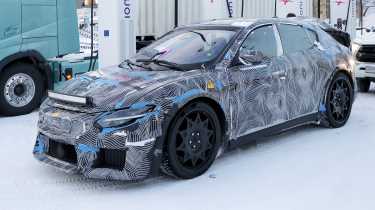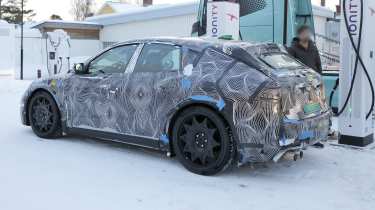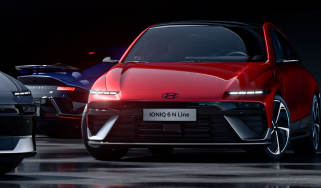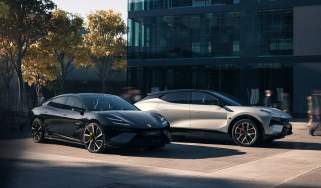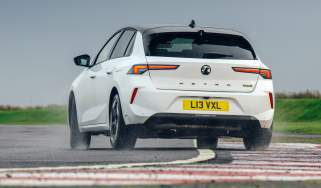Ferrari Elettrica confirmed for October reveal
Ferrari will reveal its first all-electric car in October 2025 and it will be called: Elettrica
Ferrari will confirm the initial specification of its first all-electric road car on October 9 2025 at its Capital Markets Day, but it may have already revealed its name - Elettrica - during the company’s shareholder conference in April. Ferrari Electric might not sound exotic for the Italian firm, but this is the car company that called one of its flagship hypercars ‘The Ferrari’ don’t forget.
> New 2025 Ferrari Roma spied testing
Development mules and discussions around an exclusively battery-powered Ferrari started in 2021, followed by the opening the new ‘Ferrari e-Building’ at its iconic Maranello site in 2023, in preparation for its next step into electric vehicles. This followed the introduction of the SF90 and 296 V8 and V6 hybrid-powered road cars, which will be joined later this summer by the hybrid-powered F80 hypercar.
The ‘Electtrica’, however, will be the first battery electric vehicle (BEV) from Ferrari, and while the company’s test mules are masters of disguising what’s beneath their Frankenstein monster’s bodywork, expect the first battery-powered Ferrari to be closer to the Purosangue in concept than a 296.
The test mules spotted testing this winter provided the closest look yet at the incoming model when it was caught at a public fast charging station in Sweden. Near-identical to previously seen test mules, wearing the butchered body of a Maserati Levante with fake quad exhaust pipes and headlights similar to the kind found on the Ferrari Roma, the latest test vehicles were undergoing their final cold weather system calibration testing ahead of their autumn 2025 reveal.
Hinting at the marque’s focus on electrification, Ferrari CEO Benedetto Vigna, said: 'The will to progress that has always characterised Ferrari has led to innovation in our infrastructure, with the inauguration of the e-building; in our products, best highlighted by the new supercar, the Ferrari F80; and in R&D, with the new E-Cells Lab that will further strengthen our electrochemical knowledge to prepare us for the future.'
The marque’s 2024 results presentation revealed Ferrari had seen a 21.3 per cent year-on-year profit increase to €1.56bn (c£1.3bn) despite it being a quiet year for new model releases. The numbers also revealed a 51:49 split between hybrid models and pure-ICE models sold last year, proving the strength of its electrified offerings.
The EV won’t be the only announcement to look forward to from Maranello this year, either, with five additional models also set for launch in 2025 with replacements for the Roma coupe and Spider in the pipe line alongside a limited run, performance variant of the 296.
Where Ferrari’s new EV will be built
In its biggest expansion in recent times, Ferrari opened a new, 42,500 square metre factory building at its Maranello HQ last year. Called the Ferrari e-building, it will house the production of a mixture of models: pure combustion, hybrid and the aforementioned EV. evo was on the ground at the building’s opening, where partners, investors, politicians and journalists were allowed inside for the first time.
A large, multi-floor factory building, this facility is designed to give Ferrari the maximum production flexibility possible: a broad mixture of cars with all kinds of powertrains can be produced here. It also gives the company pure electric car production capability for the first time. There is a dedicated station on an upper floor for the components of future EVs and hybrids, including automated machines to install the rotors and stators of Ferrari’s own electric motors, production stations for EV transmission components in aluminium casings, and benches for e-axle quality-control testing.
The new e-building occupies a new area at the north edge of the existing Ferrari campus. It’s the first time in many years that Ferrari has extended its Maranello base beyond its previous limits, buying and developing new land to do so. Three hundred people will work in the new e-building when production ramps up; around 5000 people work at Maranello total.
High-tech factory systems bring the e-building fully up to date; for example, ultra-wide band connectivity which enables the production team to check if a tool is in the right position or if it has been misplaced.
In its electrified models thus far, Ferrari has sourced its electric motors from external suppliers. Creating its own motors in-house not only gives it advantages in terms of intellectual property and supply chain logistics, but also affords it more protection from external market factors. One of the biggest immediate wins for Ferrari will be greater flexibility and speed in creating personalisation requests for customers – a lucrative aspect of its business.
Ferrari will design and assemble batteries here, but the battery cells will be sourced from external suppliers. Cell supplier is TBC: ‘We are working with more than one supplier,’ Vigna says, ‘we have several partners and we are continually investigating.’ In addition, Ferrari has opened an ‘e-lab’ with the University of Bologna, to research and share technology related to battery cells.
